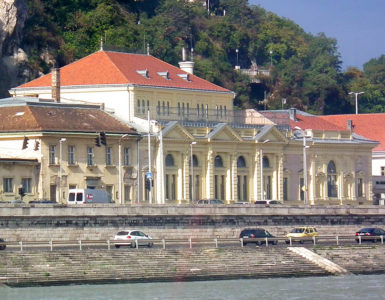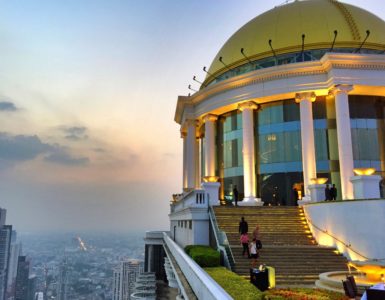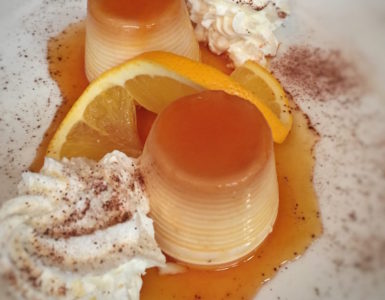Before the trip to Tampa, I spent the required time on TripAdvisor, leveraging the wisdom of crowds to find tips on things to do.
Number one on TripAdvisor’s list? Taking in a show at the Tampa Theater — a local parallel to Atlanta’s Fox Theatre (right down to the Wurlitzer organ played prior to big events). Number two is a large cat park, an attraction with absolutely zero appeal to our traveling companions. Number three is a performing arts center, number four is a park, and number five is the Sunshine Skyway Bridge (which, as one reviewer notes, “is just a bridge”).
Number six, however, showed promise: Wat Mongkolrata, a Buddhist temple in the Thai tradition. Wat Mongkolrata seemed to offer the opportunity to experience the Thai vibe I enjoy without investing twenty-four hours in travel time. Imagining myself strolling the deserted grounds or praying in the silent temple, I added Wat Mongkolrata to my must-see list.
As it turned out, our friends had also added the temple to their list, for different reasons.Having taken time to actually read reviews of the attraction (“join the crowds … great food … don’t miss the Sunday brunch”), they had scheduled our visit for Sunday morning and were looking forward to a less spiritual and more culinary experience.
Sunday Brunch? At a Thai temple? In Florida? In my head, I pictured a buffet laid out in the temple itself, right in front of the Buddha statue. Obese tourists jostled for position, carrying tiny plates piled high with eggs benedict and prefab pastries.
I’ve never been more wrong.
Wat Mongkolrata is off the main drag: across the railroad tracks, behind a thick grove of scrub pine, and across the street from a Baptist church. As you drive onto the grounds, you’ll see the temple nestled in clearing:
Any sense of being in Tampa falls away, thanks to the temple’s location on a river (which, frankly, does look a lot like the Chao Praya) and the hand-lettered signage (in Thai) tacked to trees along the road.
The fact that Tampa could so quickly feel like Thailand was a surprise — but the energy of the place was a surprise on an entirely different order. The temple grounds were swarming with happy, friendly people:
Despite the fact we were very early, a large number of people had already made the pilgrimage down the shallow hill to a large, covered pavilion, the source of intoxicating aromas: basil, coconut, cooked meat, fried food. We didn’t waste any time — in fact, in our hurry, we made a rookie mistake and forgot to survey all the options before picking a line — and dashed inside. The first thing we encountered? The fried bananas:
Imagine a banana, sliced in half lengthwise, pounded flat, dipped in thick tempura batter, and fried up in a huge, hot, well-seasoned wok. I snapped up a bagful for two bucks, and personally attest to the fact that the result is crispy outside, sweet and decadent (a bit like hot soft-serve ice cream) on the inside.
From there, we ran to the shortest line we could find, which turned out to be the entrees line. For five bucks, Thai volunteers serve up larb gai (minced chicken with mint and pepper), noodle soup, basil chicken, and spicy chicken curry. (The pad thai and spring rolls, sadly, weren’t yet ready.)
I ordered in Thai, which drew smiles from the workers. (“That’s really good,” one woman said — and I think she gave me extra fried rice, to boot.) We carried our styrofoam treasure chests to a space by the river, snagged ourselves one of the few open picnic tables, and tucked in:
It was only later that we spotted the additional lines. In the little wooden shacks to the side of the main pavilion, a group of women sold Thai barbecue chicken with peanut sauce. Closer to the river, you could buy orchids, fresh vegetables, and citrus trees:
And back behind the main pavilion was a long entryway where you could pick up traditional Thai sweets (not really sweet enough for American tastes — think bean paste or rice flour with a hint of sugar) and sticky rice with mango:
I was, as usual, obsessed with the temple — and a bit disappointed at what I found inside. In Thailand, the interior of a temple this grand would be dominated by a huge Buddha. There would be no seating; instead people would be seated on the floor, with their feet pointed away from the Buddha image, praying. It might not be quiet — temples double as community centers, and the noise level can be amazing — but it would be … reverent.
The outside of the temple intrigued us:
And while the interior had its charms, it struck me as a bit chilly — not an adjective I’d ever use to describe a temple in Thailand:
A local (American) gentleman was there, microphone in hand, answering (the very few) questions asked by folks like us who had wandered inside. But because he was situated in the doorway, people tended to walk in and sit right down instead of exploring the interior of the temple. Even though he mentioned you could bypass him and go on inside, doing so just seemed rude … so we didn’t.
Had we driven out to Wat Mongkolrata on a week day, we would have enjoyed seeing the temple grounds, the riverside setting, and the temple exterior … but what made this spot the highlight of the Tampa trip for me was the very authentic festival atmosphere of the Sunday brunch. I’m so glad we didn’t miss that!





Add comment